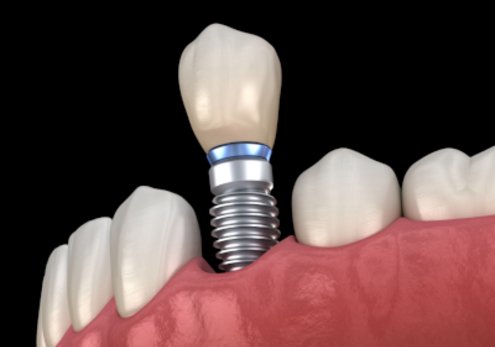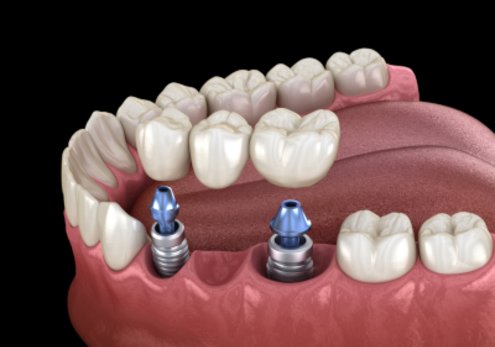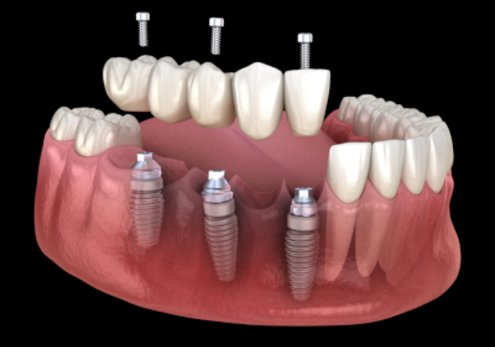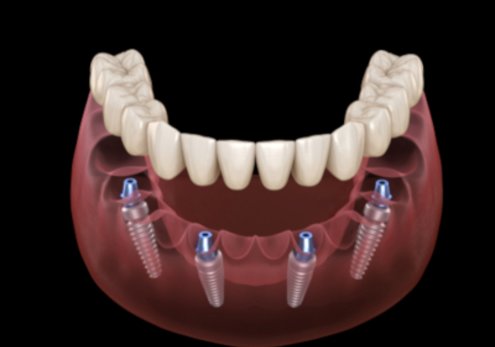Reconstruction of missing teeth with implants is currently the most modern solution that allows you to obtain aesthetically and functionally teeth corresponding to your own natural teeth.
What is an implant?
Simply put, an implant is the equivalent of the root of the lost tooth, on which the prosthetic part - a single crown, a bridge or an overdenture - is fixed, depending on the missing teeth.
What material is the implant made of?

The key aspect in this field of dentistry is the use of a special biocompatible metal, titanium. Its unique properties allow the integration of the implant with the natural bone in a process called osteointegration. It is noteworthy that the discovery of such a unique interaction was awarded with the Nobel Prize in the field of medicine. Since then, implant prosthetics has become the most important field of dentistry, opening the possibility of restoring missing teeth, in a way that is safe for the body that were previously completely unknown.
The implant is a screw made of titanium with a surface that has been further modified to obtain the best possible integration with the bone.
The implantologist introduces an individually selected screw in the maxilla or mandible in the area of the lost tooth, while in the next stage a crown is attached to the screw.
Can the metal from which the implant is made cause an allergic reaction?
The keys to success in implant prosthetics are the unique properties of the material the implant is made of. A breakthrough discovery of the phenomenon of osseointegration, i.e. the physical connection between bone and the surface of the titanium, allowed for the use this material in the vast majority of implant systems. The body treats the titanium implant as a fragment of itself, not only by not rejecting the material, but also creating neuron connections responsible for the emergence of the osseoperception phenomenon – the ability to "sense" the structure and the food consumed and the force that arises during biting on the reconstructed teeth, similarly as in natural teeth. This makes the patient gradually almost forget about having this type of restoration and normal daily functioning is the same as with natural dentition.
Is the placement of implants painful?
The implant placement procedure is completely painless and takes place under the regular dental local anesthesia. Due to the use of atraumatic techniques, it is often less invasive than the extraction of the tooth that the implant is to replace. In addition, in order to maintain perfect precision, the implantologist often uses an individually designed surgical template that allows the implant to be placed in the optimal position.

At the end of the first stage, the incision made to expose the bone is sutured and the implant is left for a period of 3 to 6 months. At this time, the osseointegration process described earlier is performed in order to obtain the maximum strength of the implant and bone connection.
I already have an implant inserted. What's next?
The implant itself would be worthless if it did not have a prosthetic part, protruding above the gingiva and responsible for function and aesthetics. After the period of osseointegration when the implant becomes fused with the bone, which takes about 3 - 4 months, the prosthetic part is installed on an intraosseous implant.
In the simplest procedure, when rebuilding a single tooth, it can be a crown, which does not significantly differ from the "ordinary" kind made on your own prepared tooth, apart from some technical differences.
Similarly, with a larger quantity of teeth missing, bridges are used in order to limit the number of necessary implants. For example, a restoration replacing four missing teeth can be a four-point bridge that can be placed on two implants (i.e. screws inserted into the bone).
For edentulous full denture users, two implants in the mandible and four implants in the maxilla may be placed, on which the overdenture will be inserted in order to improve comfort. This is the simplest solution that can be modified, depending on the specific clinical situation, even to a twelve-point bridge that restores the teeth from tooth number "six" to "six", based usually on six implants.
Therefore, dental arch reconstruction with implants opens up a huge number of possibilities, from replacing a single tooth to rehabilitating patients with edentulism.
During this time after implantation, will I still be without teeth for the next 3-6 months?
No this will not occur. Even though, the final prosthetic reconstruction cannot be placed yet, in the described time the patient is aesthetically and functionally secured with a temporary restoration in the form of a temporary crown, bridge, splint or denture - depending on the number of teeth being replaced. Therefore, implant surgery does not require a period of time that limits social interactions. The patient can return to normal functioning immediately after the procedure.
What if I do not have an adequate amount of bone in order to place implants?
Often, patients are concerned that in the case that their jaws do not have enough bone structure, it will be impossible to place implants. Indeed, this is an important aspect, assessed initially during planning such a treatment, but even in the case of a small amount of maxillary and mandibular bone levels, the implantologist has the option of increasing it by guided bone regeneration and sinus lifting.
Implant prosthetics step by step
- The first visit is a thorough examination, including the general anamnesis, in order to qualify the patient for implant treatment. Due to the high involvement of the patient's body in the implantation process, it is important to stabilize the general health and eliminate harmful habits that could cause problems at every stage of treatment. It is particularly important to give up smoking, which, according to the results of many clinical trials, makes it difficult to integrate the implant with the bone. The doctor also assesses the condition and level of bone in which the implant will be placed, based largely on a radiological examination. In the case of an insufficient amount of bone, it is necessary to undergo bone regeneration or sinus lifting. These are treatments that aim to increase the space available for the implant. Depending on the technique used, synthetic materials, natural or obtained from the patient himself (i.e. autogenous grafts) are used. At this stage, it is very important to get acquainted with the treatment plan prepared by the doctor and any alternatives. A thorough understanding of the advantages and disadvantages of each solution allows you to choose a satisfactory treatment option.
- The next visit involves a surgical procedure – the placement of the implants. Under local anesthesia, the surgeon prepares the bone and then inserts the implant, making sure that the implant is properly stabilized. The mucous membrane is sutured shut over the implant and it is left in the bone for three months if placed in the mandible and from four to six months in the maxilla. At this time, the osseointegration described above occurs, and the patient is protected functionally and aesthetically with temporary restorations.
- After the described period, the implant is uncovered, and the healing abutment is placed. For 14 days, it helps with healing and shaping the mucous membrane, so that it can better complement the future crown or other planned restoration.
- After 14 days the prosthetic part is made. Depending on the type of restoration, a slightly different procedure is involved, but it essentially consists taking impressions, and then developing a connector in the laboratory, which is the connecting element between the implant and the crown or other prosthetic restoration.
- The last visit consists of screwing in the connector and cementing or screwing in the prosthetic restoration.
After 3-6 months, the patient comes for subsequent visits during which the doctor uncovers the implant and assembles the appropriate prosthetic restoration. Depending on the missing teeth in our Clinic, we suggest the following solutions:
Write to us
Offer
Warszawa Ochota
Adres:
ul. Dorotowska 9
02-347 Warszawa
Telefon: +48 501 328 772
E-mail: recepcja@ddclinic.pl
Godziny otwarcia:
Poniedziałek - Piątek: 9:00 - 20:00
Sobota: nieczynne
Warszawa Ursynów
Adres:
ul. Migdałowa 10 lok.5
02-796 Warszawa
Telefon: +48 502 070 050
E-mail: recepcjaursynow@ddclinic.pl
Godziny otwarcia:
Poniedziałek - Piątek: 12:00 - 20:00
Sobota: nieczynne






